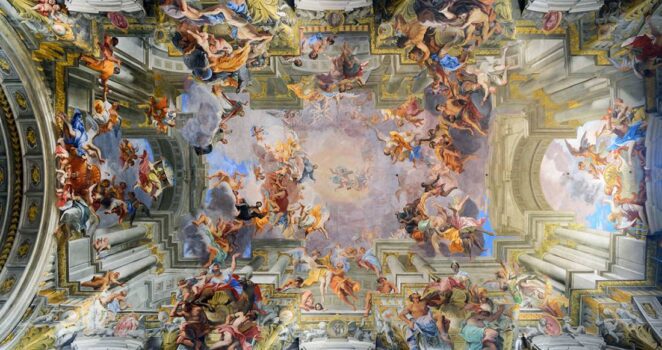The Apotheosis of Saint Ignatius: Story and Meaning
When you step into the Jesuit church of Sant’Ignazio di Loyola in Rome and look upward, they are suddenly transported into a breathtaking vision where heaven seems to open above their heads. The ceiling dissolves, architecture melts into radiant sky, and a celestial drama unfolds as the founder of the Society of Jesus, Saint Ignatius of Loyola, is lifted in glory. This extraordinary fresco, known as the Apotheosis of Saint Ignatius, is one of the greatest achievements of Andrea Pozzo, the master of Baroque illusionism. More than a mere decorative ceiling, it is a visual manifesto of the Jesuit mission, a theological statement, and an emblem of Baroque spirituality. To understand it is to enter into a dialogue between faith, art, and philosophy.
The Story of The Apotheosis of Saint Ignatius Painting
The church of Sant’Ignazio was built in the late 16th century as the principal church of the Roman College, the Jesuit center for learning. Though its architecture was completed by 1626, its vast central nave was left with an unadorned ceiling for decades. By the late 17th century, the Jesuits sought to embellish this vast space with a fresco that would glorify their founder and communicate the universal mission of the Society of Jesus.
The task was entrusted to Andrea Pozzo (1642–1709), a Jesuit brother, painter, and theorist of perspective who had trained in the traditions of the Lombard and Roman Baroque. Pozzo was not only a skilled painter but also a mathematician and stage designer. He wrote a famous treatise on perspective, Perspectiva Pictorum et Architectorum, which became a standard reference for artists across Europe. His unique ability to merge painting with architecture made him the perfect choice for the ambitious project.
Between 1685 and 1694, Pozzo worked tirelessly on the immense fresco, covering the ceiling of the nave, measuring some 17 meters wide and nearly 36 meters long, with a painting that seemed to abolish the boundaries of the church’s architecture. His mastery of quadratura, the illusionistic extension of real architecture into painted space, allowed him to create the illusion of a dome where none existed. The result was nothing less than a spectacle of divine glory, meant to inspire awe and devotion among worshippers.
What the Fresco Depicts: The Heavenly Vision
At its center, the fresco presents the radiant figure of Saint Ignatius of Loyola, the Spanish soldier-turned-mystic who founded the Jesuit order in 1540. Ignatius is shown being received into heaven, carried aloft by angels and bathed in divine light. Around him, the heavens open in a burst of golden radiance, while Christ and the Virgin Mary appear in glory above, welcoming him into celestial fellowship.
From Ignatius, rays of divine light spread outward, extending toward the four corners of the earth. At each corner of the fresco, allegorical figures represent the four continents known to Europeans in the 17th century:
Europe, portrayed with regal attributes and Christian symbols.
Asia, adorned with exotic garments and references to Eastern culture.
Africa, depicted with rich textiles and sometimes a lion.
America, shown with feathers, weapons, and references to the New World.
Each continent is accompanied by putti and personifications of virtues, receiving the illumination of Ignatius’ mission. This reflects the Jesuit idea that their founder’s inspiration, his obedience to God and his zeal for souls, radiates across the globe through the missionary work of his order.
One of the most astonishing aspects of the Apotheosis is its illusionistic perspective. Pozzo designed the fresco to be viewed from a single marble disk set in the nave floor. Standing at this spot, the viewer sees the ceiling dissolve into infinite space, the architecture continuing upward into an open sky.
Pozzo used techniques of quadratura (painted architecture) to extend the church’s cornices, columns, and arches seamlessly into painted structures. What appears to be a grand dome overhead is, in fact, a flat surface. The illusion is so convincing that even today, visitors often find themselves disoriented by the blending of real and painted architecture.
This mastery of illusion was not a mere trick: it reflected the Baroque aim to engage the senses, overwhelm the viewer, and direct the soul toward God. For the Jesuits, whose pedagogy emphasized imagination as a path to spiritual insight (as outlined in Ignatius’ Spiritual Exercises), such visual immersion was a powerful tool for meditation.
The Apotheosis of Saint Ignatius Symbolism and Meaning
The fresco is dense with symbolic layers. To unpack its meaning, one must read it both theologically and politically.
1. Ignatius as the Mediator of Divine Light
Ignatius, shown radiating divine light, represents not just his personal sanctity but the Jesuit mission itself. Light in Baroque art often symbolizes divine truth; here, Ignatius acts as a prism through which God’s truth shines onto the world. His elevation signifies not only his canonization (he was declared a saint in 1622) but also his role as an exemplar of obedience and devotion.
2. The Four Continents
The representation of Europe, Asia, Africa, and America illustrates the global reach of the Jesuit order. By the late 17th century, Jesuits were active in China, Japan, India, Africa, and the Americas. The fresco thus celebrates their missionary success and frames it as a fulfillment of Christ’s command to spread the Gospel to all nations.
3. The Triumph of the Jesuit Mission
The fresco also functions as propaganda for the Jesuit order, which had faced criticism and opposition in Europe. By portraying Ignatius as a heavenly figure whose influence spans the globe, Pozzo underscored the legitimacy and divine sanction of the Jesuit enterprise.
4. Theological Allegory
The composition echoes the Jesuit emphasis on finding God in all things. Ignatius, once a worldly soldier, now channels his zeal toward spiritual conquest. The fresco depicts him as a soldier of Christ, conquering not by the sword but by the light of the Gospel.
What Type of Art Is The Apotheosis of Saint Ignatius?
The Apotheosis of Saint Ignatius belongs to the Baroque period, specifically the Roman High Baroque style of the late 17th century. Characteristics of this style are abundantly present:
Dramatic illusionism: The blending of painting and architecture into a seamless vision.
Theatricality: The fresco resembles a celestial stage set, echoing Pozzo’s experience as a stage designer.
Movement and energy: Figures seem to soar, twist, and gesture with dramatic dynamism.
Emotional intensity: The viewer is meant to feel awe, humility, and inspiration.
Within Baroque art, Pozzo’s work is an exemplar of quadratura and trompe-l’œil ceiling painting, arts that reached their zenith in Rome in this period.
What Is Happening in The Apotheosis of Saint Ignatius?
To narrate the fresco as a story:
At the very center, Ignatius is being lifted into heaven. His body is angled upward, his arms spread in openness to divine grace.
Above him, the Holy Trinity and the Virgin Mary preside, signifying his acceptance into the heavenly court.
Surrounding Ignatius, angels and allegorical figures celebrate his triumph.
Rays of light burst outward, touching the four corners of the world, where the allegories of the continents await. Each continent is depicted with its attributes, accompanied by cherubs carrying emblems of conversion and learning.
The illusionistic architecture frames this cosmic scene, suggesting that the church itself has opened to reveal heaven.
The viewer, standing in the nave, is invited to participate in this vision, almost as if they are part of the earthly congregation looking upward into eternity.
The Painting as Jesuit Propaganda
While the fresco is primarily a spiritual vision, it also served a political purpose. In the 17th century, the Jesuits were powerful but controversial. They had amassed influence in education and missionary activity, but also faced accusations of meddling in politics. The fresco asserts the divine legitimacy of their mission, presenting Ignatius as a saint whose work is not merely human but divinely ordained.
By linking Ignatius’ glory with the Jesuit missionary enterprise, Pozzo’s painting was a visual defense of the order’s global expansion. For students and visitors to the Roman College, the message was clear: to be a Jesuit was to share in this glorious mission.
Andrea Pozzo, The Artist Behind the Vision
Andrea Pozzo’s role cannot be overstated. Unlike many painters who worked under patrons, Pozzo was himself a Jesuit, deeply invested in the theology he painted. His dual vocation as artist and religious brother allowed him to integrate the Jesuit spiritual worldview with the most advanced artistic techniques of his day.
Pozzo’s treatise on perspective, published in 1693, codified the methods he used in Sant’Ignazio. His innovations influenced ceiling painting across Europe, inspiring works in Vienna, Munich, and beyond. But the Apotheosis of Saint Ignatius remains his masterpiece, the fullest expression of his genius.
Where Is The Apotheosis of Saint Ignatius Painting Today?
The Apotheosis of Saint Ignatius is still located in the church for which it was created: the Chiesa di Sant’Ignazio di Loyola in Campo Marzio, Rome. The church, a jewel of Jesuit architecture, is open to visitors, and the fresco continues to astonish tourists, pilgrims, and art historians alike.
Interestingly, because the church was never completed with a real dome, Pozzo also painted a false dome at the crossing using the same illusionistic techniques. This second masterpiece reinforces the theme of the eye’s deception and the mind’s enlightenment, a metaphor for spiritual insight.
The Meaning of the Apotheosis
The Apotheosis of Saint Ignatius is more than a painted ceiling; it is a theater of heaven, a catechism in color, and a declaration of Jesuit identity. Through the soaring vision of Ignatius’ elevation, Pozzo transformed a flat ceiling into a window to eternity. The fresco celebrates not only one man’s sanctity but the global mission of the Jesuits, the universality of Christianity, and the power of Baroque art to move hearts and minds.
For the modern viewer, the fresco continues to offer a glimpse into the Baroque imagination: a world where heaven is near, the boundaries between the earthly and divine dissolve, and art becomes a vehicle of revelation. Standing in Sant’Ignazio and looking upward, one experiences the awe intended by Pozzo and his Jesuit patrons, a reminder of the power of vision, both artistic and spiritual.




